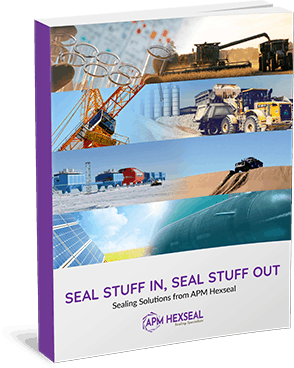O-RINGS ARE CRITICAL COMPONENTS FOUND IN COUNTLESS INDUSTRIES.
These small, donut-shaped seals are designed to prevent liquids or gases from escaping tubing or piping. In most cases, o-rings are made from elastomeric materials—polymers that can stretch and return to their initial shape.
When selecting the best polymer o-ring for your application, consider several key variables, such as durability, chemical resistance, temperature range, and cost requirements.
On this page, you’ll learn more about the six primary elastomer materials APM Hexseal uses to manufacture elastomeric rings:
- Silicone
Silicone
This synthetic polymer is made of oxygen, hydrogen, carbon, and silicon. Similar to silicon dioxide or silica, silicone has added organic groups via C-Si bonds.
For commercial and industrial applications, silicone provides excellent flexibility and resistance to steam, water, and most chemicals. The material can tolerate extreme temperatures ranging from -100 °F to 500 °F (-73 °C to 260 °C). Silicone is also great for outdoor applications because they resist wear caused by ozone and UV light exposure. Its high strength and low compression set make it ideal for o-ring applications, especially those in the medical and automotive industries.
Silicone o-ring elastomers are a cost-effective option that can be customized by color, size, and other specifications. Features include:
Compound Letter & Code:S 2701Relevant Specifications:A-A-59588, Class 2, GR60 or GR70Service Temperature:-80 °F to +425 °F (-62 °C to +219 °C)Tensile PSI:500-1800Elongation %:100-800Abrasion Resistance:RecommendedCompression Set:Recommended - Fluorosilicone
Fluorosilicone
Fluorosilicone is a polymer with the properties of fluorocarbon polymers and silicone. When compared to silicone, fluorosilicone offers superior temperature tolerance and chemical resistance. O-rings made from this material can withstand temperatures from -80 °F to 400 °F (-62 °C to 204 °C). Fluorosilicone has excellent resistance to oils, fuels, and many other hydrocarbons.
Like silicone, fluorosilicone has excellent resistance to ozone and UV radiation. The material’s ability to withstand environmental exposure and hydrocarbons makes it an excellent solution for the aerospace, automotive, and oil and gas industries. Features include:
Compound Letter & Code:L 2615Relevant Specifications:MIL-DTL-25988C, Type 1, Class 1, GR60 or GR70Service Temperature:-70 °F to +392 °F (-57 °C to +200 °C)Tensile PSI:600-1400Elongation %:100-700Abrasion Resistance:FairCompression Set:Recommended - Viton® A
Viton® A Performance Elastomers
Viton® A is a fluoroelastomer designed and patented by the DuPont company. In addition to having excellent mechanical properties, Viton® A offers resistance to temperatures from -20 °F to 400 °F (-29 °C to 204 °C). The material can also withstand exposure to chemicals like oils, fuels, bases, and acids.
This high-temperature o-ring material performs well outdoors, as it can tolerate UV radiation and ozone exposure. Viton® A can be found in nearly every industry that works with high temperatures, specifically chemical processing and automotive applications.
Compound Letter & Code:V 5701Relevant Specifications:ASTM D2000 75 DurometerService Temperature:-13 °F to +482 °F (-25 °C to +250 °C)Tensile PSI:2000-2200Elongation %:300-400Abrasion Resistance:SufficientCompression Set:Fair - Buna N (Nitrile)
Buna N (Nitrile)
Also known as nitrile rubber or acrylonitrile butadiene rubber (NBR), Buna N is a synthetic polymer derived from butadiene and acrylonitrile. The material has good resistance to oils and fuels, in addition to possessing excellent mechanical properties.
The nitrile rubber o-rings can tolerate temperatures spanning -40 °F to 250 °F (-40 °C to 121 °C). It can also tolerate outdoor environments thanks to its resistance to ozone and UV radiation exposure. Buna N O-rings can be found in most industries where oils and fuels are used, particularly in the industrial machinery and automotive industries.
Compound Letter & Code:N 4601Relevant Specifications:ASTM D2000 70 DurometerService Temperature:-40 °F to +212 °F (-40 °C to +100 °C)Tensile PSI:1500-3000Elongation %:400-600Abrasion Resistance:RecommendedCompression Set:Fair - Neoprene
Neoprene
Neoprene is a synthetic polymer derived from chloroprene. The polymer provides good mechanical properties and chemical resistance, tolerating exposure to oils, fuels, acids, and bases.
Neoprene performs well with extreme temperatures ranging from -40 °F to 250 °F (-40 °C to 121 °C). Neoprene is well-suited for outdoor use, as it is resistant to ozone and UV radiation exposure. These properties make it common in the sporting goods and construction industries.
Compound Letter & Code:E 3601Relevant Specifications:ASTM D2000 70 DurometerService Temperature:-67 °F to +212 °F (-55 °C to +100 °C)Tensile PSI:1500-4000Elongation %:100-700Abrasion Resistance:FairCompression Set:Sufficient - EPDM
EPDM (Ethylene Propylene)
The synthetic polymer EPDM—short for ethylene propylene diene monomer—is derived from ethylene, propylene, and diene monomer. In addition to temperature and chemical resistance, EPDM provides good electrical insulation.
O-rings made from EPDM can tolerate temperatures ranging from -60 °F to 300 °F (-51 °C to 149 °C). The material is also resistant to wear from acids, bases, water, ozone, and UV radiation. The polymer is widely used in applications where chemical resistance and electrical insulation are priorities. EPDM is a popular o-ring material type for the water treatment and automotive industries.
Compound Letter & Code:F 7601Relevant Specifications:ASTM D2000 70 DurometerService Temperature:-67 °F to +212 °F (-55 °C to +100 °C)Tensile PSI:1400-1600Elongation %:500-600Abrasion Resistance:FairCompression Set:Recommended
ADDITIONAL CONSIDERATIONS
In addition to chemical resistance, temperature range, and environmental exposure, engineers often consider these variables when selecting the ideal elastomer o-ring for an application:
Durability
Cost
Customization
Compatibility
Environmental considerations
Special considerations
ELASTOMER O-RINGS, SEALS, AND GASKETS FROM APM HEXSEAL
With so many material options available in o-ring manufacturing, it can be difficult to select the right one for your application.
Since 1947, APM Hexseal has been a trusted provider of sealing solutions, such as o-rings and gaskets. Our team can help you choose the best solution based on your unique requirements. We’ll assist you in evaluating temperature ranges, chemical resistance, service life, durability, cost, and all other applicable variables.
To Get Started, Contact Us.
Already have a project in mind? Request a Free Quote Today.






